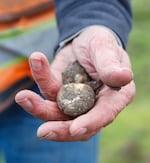
Juliette Fernandez, right, with the U.S. Fish and Wildlife Service, Jasmine Zimmer-Stucky and Doug Kruger with the Lower Columbia Estuary Partnership dig holes for wapato bulbs in the newly restored wetlands at the Steigerwald National Wildlife Refuge on Nov. 22, 2021.
Cassandra Profita / OPB
WASHOUGAL, Wash. — Native American tribes could someday resume their tradition of harvesting a prized first food — the potato-like tuber, wapato — from the wetlands along the Columbia River in the Steigerwald National Wildlife Refuge.
The area was drained years ago and cut off from the river by levees, but a $31 million restoration project has removed about 2 miles of those barriers to restore 965 acres of floodplain habitat.
It’s the largest wetland restoration project on the lower Columbia River, designed to re-establish valuable salmon habitat while reducing flood risks to the area. The newly restored wetlands will benefit a variety of native species including lamprey, beaver and migratory birds. It’s also creating the perfect habitat for wapato, a tuber that grows in wetlands and was once so abundant along the Columbia in Southwest Washington and Northwest Oregon that Lewis and Clark named the area Wapato Valley.
The U.S. Fish and Wildlife Service and its partners, including the Lower Columbia River Estuary Partnership, will plant 3,000 wapato bulbs and 30,000 seeds in the wetlands for future tribal harvest.

Wapato is a tuber that looks like a small potato and grows primarily in wetlands.
Cassandra Profita / OPB
Sam Robinson, vice chairman of the Chinook Indian Nation, joined in a ceremonial planting of wapato at the restoration site on Monday and sang a song in honor of the positive change at the refuge.
“Wapato was such a huge resource from this area here down to Longview and through Portland,” he said. “It was a huge trade item. So, as they were harvesting this wapato, they were bringing it down to where my relatives were and trading it for fish oil. ... Maintaining refuges like this is so valuable.”
Robinson said it would normally be this time of year that tribal members would start harvesting wapato, after the plant had died back and sent all of its nutrients into its root system. He said he is looking forward to seeing the restored wetland evolve so that tribal members can harvest wapato at the site in the future.

Sam Robinson, vice chairman of the Chinook Indian Tribe, sings a song about the changes taking place during a massive wetland restoration project at the Steigerwald National Wildlife Refuge in Washougal, Wash.
Cassandra Profita / OPB
Wapato tastes like a potato but it has a bit more nutrition in it, according to Curtis Helm, restoration ecologist with the Lower Columbia River Estuary Partnership.
“It has a little more iron in it, cooks easily. It’s easily stored and easily dried,” he said. “But you have to know where the plant was growing in order to harvest it because the above-ground plant dies in the fall.”
Helm said numerous factors have reduced the amount of wapato in the Northwest, including the loss of floodplains as the Columbia River was diked for farming, but also invasive species and competing crops like potatoes.

Alvey Seeyouma of the Hope-Tewa tribe plants a wapato bulb in the wetland created by a $31 million restoration project at the Steigerwald National Wildlife Refuge
Cassandra Profita / OPB
Juliette Fernandez, project leader with the Ridgefield National Wildlife Refuge Complex, said she is grateful for her agency’s partnerships with Northwest tribes.
“On many of our refuges we have native plants that were also first foods that continue to be harvested by our tribal partners,” she said. “Working with them not only to understand biology of the plants but to create harvest opportunities has been really been meaningful. This week, as we have Thanksgiving and as we all sit down to enjoy our various forms of food and the things that are important to us in our lives, that’s one relationship I’m thankful for this year.”
